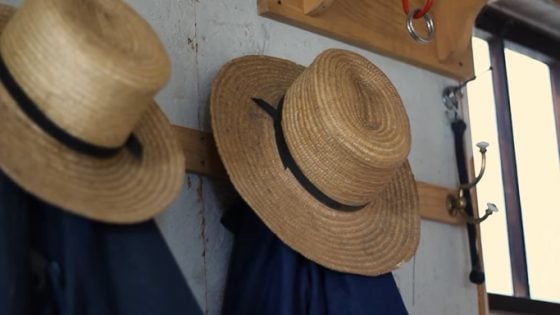Ohio Beard Attack Convictions Overturned
From the Associated Press:
An appeals court panel on Wednesday overturned the hate-crime convictions of 16 Amish men and women in beard- and hair-cutting attacks on fellow members of their faith in Ohio, ruling that religion wasn’t their driving motive.
A 6th U.S. Circuit Court of Appeals panel sided with arguments brought by attorneys for the Amish, convicted two years ago in five attacks in 2011. The attacks were in apparent retaliation against Amish who had defied or denounced the authoritarian style of Sam Mullet Sr., leader of the Bergholz community in eastern Ohio.
In a deeply divided decision, two of the three judges on the panel concluded that the jury received incorrect instructions about how to weigh the role of religion in the attacks. They also said prosecutors should have had to prove that the assaults wouldn’t have happened but for religious motives.
“When all is said and done, considerable evidence supported the defendants’ theory that interpersonal and intra-family disagreements, not the victims’ religious beliefs, sparked the attacks,” the judges wrote.
Dissenting judge Edmund A. Sargus, Jr. “wrote that religion was a clear motive for the 2011 attacks and that the hate-crime convictions were appropriate, especially against Mullet.”
Sam Mullet is serving a 15-year sentence while seven others are serving between five and seven years.
Defense attorney Wendi Overmyer will now likely seek their release.
UPDATE: In an article for TIME magazine, Donald Kraybill discusses the effects of this decision on future hate crimes prosecution. He suggests that if the appellate court’s more restrictive interpretation goes unchallenged, then future hate crimes prosecutions will be more difficult.






judicial intervention
IMPROPER JURY INSTRUCTIONS? Baloney! In my opinion, when an appellate court makes a ruling like this they are being liberals and nice to the defendants by not stating the true reason for overturning the verdict, which is that they felt the sentence was excessive and they simply wish to use their position to shorten the sentences. All it takes is two out of the three judges on the appellate panel to find a factual issue on which to reverse or overturn the decision, resulting in early release for some of the defendants ( I think one woman has already been released after doing her sentence). And the fact it took this long to get the opinion of a higher court to review the trial proceedings, is sinful. Ecclesiastes 8:11 “Because sentence against an evil work is not executed speedily, therefore the heart of the sons of men is fully set in them to do evil.” THIS IS WHY PEOPLE DO NOT FEAR DOING EVIL!! Along with the failure of Caesar to use the sword for punishment as mandated in Romans 13:4 and First Peter 2:13,14 etc.
basis for comment
Mr. Moyer,
What is the basis for your rejection of the Court of Appeals decision. Do you dispute the validity of the dictionary they used? Do you disagree with their examples on page 6 of the decision? How would you define the phrase “because of”? What is your interpretation of 18 U.S.C. § 249(a)(2)(A)? Do you also disagree with the Supreme Court’s holding in Burrage?
James Stytle
Attorney-at-Law
reply to attorney
Sorry for not responding sooner, Dan, but I live on a sailboat and do not have internet access unless I come onshore to a public place like a library or McD’s for wifi access. I have read the comments to date and would like to know if the prosecutor has filed or will file a petition for Cert. either for en banc review by the entire Court of Appeals judges or to the Supreme Court? Have the defendants been released?
Also, you note the dissenting opinion (part quoted below) is not binding on other judges, but the main opinion is really not changing or making any new requirement upon future hate crime prosecutions, is it?
DISSENTING QUOTE: “In a strong dissenting opinion of the 6th Circuit’s Wednesday ruling, Judge Edmund A. Sargus, Jr. wrote that religion was a clear motive for the 2011 attacks and that the hate-crime convictions were appropriate, especially against Mullet.
Sargus quoted several statements made by Mullet acknowledging his religious motivations, including in an interview with The Associated Press in which he said that the goal of the hair-cutting was to send a message to the Amish community and that he should be allowed to punish people who break church laws.”
SO WE SEE that the other two judges are nit-picking, by declaring the jury instruction was improperly worded. In many cases similiar to this one, the appellate courts have simply found the trial court’s error was harmless based on evidence as quoted by the dissenting judge above, and refused to remand or require another trial, which probably won’t happen since the witnesses (other Amish) aren’t out for blood, even though the prosecutor might like to try it again. Then again, different jurors might find a different verdict!! So my first comment here simply stated the appellate court was using their power to alter the sentences of the defendants by finding a de minimis legal point on which to pontificate! I have 26 years of litigation experience, some of it from inside the system doing work for other inmates, and I have seen this same tactic used time and again–when the appellate court judges get “moved”, they will find any arcane or esoteric issue of law or fact in which to take control of the outcome of the case. I could get more specific, but then I would be writing a book!!
The community
I assume that the community will be inclined to forgive these people but I recall some who were interviewed at the time expressed their fear of the leader. I wonder how they will go about integrating these folks back into their society….
Forgive me, but what do goes the AA community think is the likelihood of Sam Mullet dying in prison, or his being released before his 15 year sentence is complete, and if he lives, is it likely he might be put under the bann for the prison time (or for being the group’s leader)? I am guessing that the Amish will probably “rehabilitate” the returned “Mulletites” if you want to call them thatto more traditional or conservativeness.
So, where from here?
I have to admit that while I don’t know the finer lines of the hate-crime laws — nor do I pretend to know all that was involved in what was committed — I must say that I struggle to see this as a legitimate case of hate crime, per se. But be that as it may….
So if the conviction of a hate crime is out, there is still the issue that this was still a crime, right? Call it assault-with-intent-to-shear — I don’t know. (ha) So even if one crime is out, isn’t there a ‘lesser’ crime that this guy is still guilty of and still should serve time for?
still a crime
Mr. Burke,
Yes, crimes were still committed. The crimes may have been hate crimes. The problem was that the jury was not properly instructed in how to apply the law.
The Court of Appeals stated, “At stake in this appeal is whether their hate-crime convictions may stand. No one questions that the assaults occurred, and only a few defendants question their participation in them. The central issue at trial was whether the defendants committed the assaults “because of” the religion of the victims.”
If the crimes were committed only because the victims professed a belief in the Amish denomination of Christianity, then the crimes were hate crimes. If the crimes were committed for other reasons, such as family disputes, then they were not hate crimes.
The Court of Appeals stated, “The federal hate-crime statute prohibits ‘willfully caus[ing] bodily injury to any person . . . because of the actual or perceived . . . religion . . . of [that] person.’ 18 U.S.C. § 249(a)(2)(A).” The jury instruction was, “a person’s actual or perceived religion was a significant motivating factor for a [d]efendant’s action . . . even if he or she had other reasons for doing what he or she did as well.” Instead of ‘significant motivating factor’, the instruction should have said ‘but for cause’.
James Stytle
Mr. Style,
Thank you for the legal analysis of the issues here.
I for one am no fan of Mr. Mullet or his group. But I think that much of what he was accused of doing (leading a cult, having affairs with his followers) is not illegal behavior. Rather it is immoral behavior.
I also did not understand charging him with federal “hate crimes” and the 15 year sentence on the basis for cutting someone’s beard. It would seem that state charges on assault would have been more apt here.
your gut is probably right
Ed,
Your gut feeling is probably right. This was probably battery and not a hate crime. If you beat up an Amish guy because he was talking to your girlfriend, that is battery. If you hate all Amish and everything they stand for, and get jealous when an Amish guy talks to your girlfriend, so you beat him up, that is battery and not a hate crime. If you beat up an Amish guy because he is Amish, that is a hate crime.
James Stytle
"Hate Crimes"
I am NOT a big fan of the concept of “hate crimes” in general. In my mind if you beat up a guy because he is Amish … you beat up a guy: period. Battery already covers that.
I see little point in making a distinction about WHY you beat the guy up. Regardless, the laws are on the books & NOT in my mind so it is a moot point.
Thanks Mr. Stytle for your informed insight. Makes understanding this decision a whole bunch easier.
Agreed.
Totally agree, Oldkat.
This is very interesting. I’m not very educated, so I want to make sure I understand this before I go about talking about it to others and expose my ignorance.
Am I understanding it that the reason this was overturned was because the jury was that the jury was given the impression that something other than religion was behind the attacks or could have been behind the attacks?
I’m also confused at what I’m hearing (locally) about the idea religion might not have been a part of the attacks. I read Donald Kraybill’s book over the weekend and living in the community where some of the victims live, I was under the impression the attacks were intended to show Dan Gmay bishops they had been wrong to lift the Bann Sam Mullet put on some of his members and shame them into adhering to his interpretation of Bann. Can you help me understand why that would be seen as not religious? I’m not trying to argue or make a point — I really am trying to make sense of this.
try to explain
Mark,
I will try to respond to your questions.
The reason the Court of Appeals remanded this suit for a new trial is that the jury were told that religion needed to be “a significant motivating factor” in the attacks. What the jury should have been told was that religion needed to be the “but for” factor in the attacks, meaning the attacks were because of religion.
The Court of Appeals did not say that these were not hate crimes. The Court of Appeals said that the jury received an incorrect instruction.
James Stytle
James,
Thank-you. That helps me understand this. The way I was hearing it I thought there was a suggestion that the attacks were not hate-crimes motivated by religion.
convictions overturned
This isn’t the first time a conviction was overturned, and won’t be the last. It doesn’t mean the “suspected” parties aren’t guilty. If I were among the Amish who still live in that community, forgiveness or not, I would keep a keen eye out for Mullet and his followers. No matter what “the court” called it, there WERE what I would consider crimes or misdemeanors involved…beards & hair were cut, people assaulted in order to do so. And now the “suspects” will be free to do what they will.
Alice Mary
not what the Court said
Ms. Mary,
You stated, “And now the “suspects” will be free to do what they will.” I do not understand the basis for that comment. The Court of Appeals clearly stated that this matter was remanded. As you yourself stated, the defendants were not found to be not guilty.
The Court of Appeals even addressed the issue of Double Jeopardy and showed that it did not apply in this situation.
James Stytle
What about the threat?
How do the authorities plan to protect the people who are afraid of Sam Mullet if he is released from prison, I wonder? With his history of death threats, I’d say Sam is a dangerous man. In at least one report, it was claimed he owned four guns.
What about the mysterious child deaths in his own community?
Sam Mullet strikes fear in the hearts of many. I don’t think we can accuse all those people of being paranoid. Someone has to heed the signs that he is a dangerous man and find a way to hold him accountable for his actions.
Well said, Saloma!
"Someone"?
Yeah, someone does — and that includes everyone that has reason to be endangered by this man. The “authorities” can cover all bases — nor should they be expected to. People who know of such a danger should be responsible for doing what they can to protect themselves.
Remember, when seconds count, the ‘authorities’ are only minutes away. Those that fail to work within that fact set themselves at risk to be bitten by that fact.
what the court didn't say
People seem to be under the impression that the Court of Appeals found that the attacks were not hate crimes. That is incorrect. The Court of Appeals did not say that these were not hate crimes. The Court of Appeals said that the jury received an incorrect instruction.
James Stytle
Attorney-at-Law
...but what the news *is* saying/implying...
James, I agree with your assessment. But the problem isn’t the people here, but (from what I’ve seen) the over-stated nature of the headlines and news (so-called) reporting. From where I sit, the problem for the average Joe/Jane is not in twisting the news of what they’ve heard, but rather in believing what they’ve heard.
over-stated nature of the headlines
A good example of media over-statement is in the article quoted at the beginning of this blog post. A paragraph begins, “In a deeply divided decision . . ..” The decision was 2-1. With a three-panel court, a decision is either unanimous or 2-1. The very make-up of the court ensures a shallowly divided decision.
source
It is always best to go the actual source for information. Journalists are experts in delivering news. Seldom are journalists subject-matter experts in the areas about which they report.
Here is a link to the actual Court of Appeals decision, which I found through a Google search.
http://www.ca6.uscourts.gov/opinions.pdf/14a0210p-06.pdf
James Stytle
A couple of minor points ...
Point 1. It has been my observation that journalists are NOT experts in delivering the news; they are experts in delivering what they want you to BELIEVE is the news, or “news worthy” anyway. Generally it seems what “makes” the news is what somehow fits the agenda of whatever news organization is delivering it.
Point 2a. If you changes the word “Seldom” in the second sentence of your first paragraph to “Almost never” it would be even more accurate than it already is.
Point 2b. Journalists go out of their way to make it APPEAR that they are subject-matter experts, when if you have ANY experience or expertise in the subject being discussed you quickly realize that most are beyond clueless.
I suspect that in you field you get a chuckle quite often about the statements / opinions on court cases that are offered up by the media.
Appeals Court beard cutting case
Thank you for this link, Mr. Stytle. I appreciate it, even though I haven’t read all 35 pages yet!
dissent
Don’t worry about reading the dissent. It is not binding. A dissenting opinion is there to give the losing judge or judges a chance to explain why the majority is wrong. It is useful for further appeals and for similar cases. It is a well-reasoned opinion on the issue, but not a binding opinion.